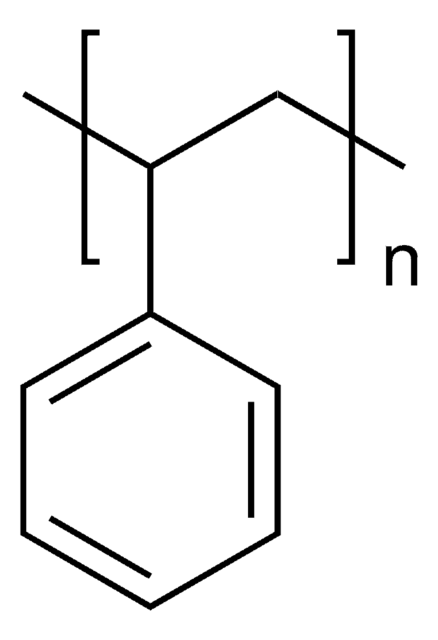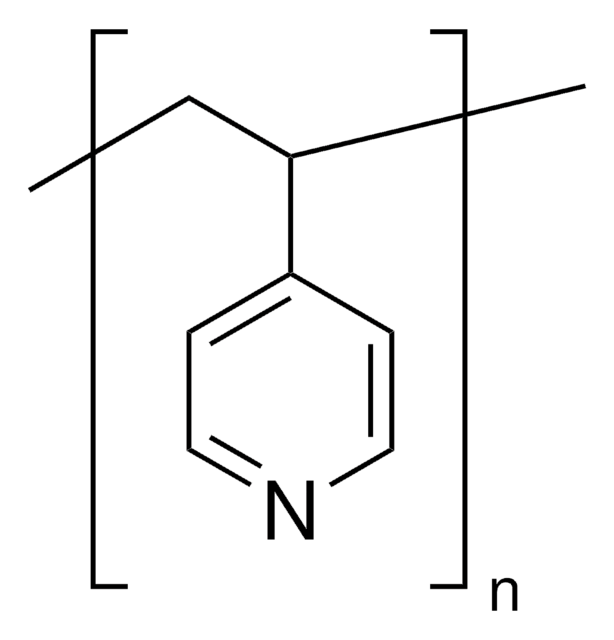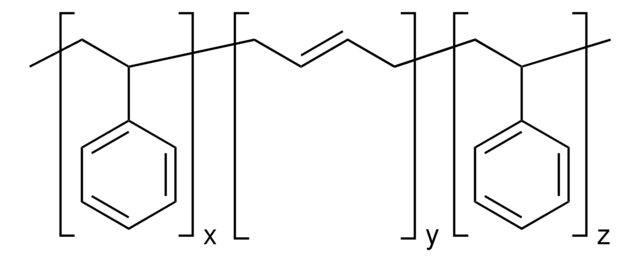Alle Fotos(2)
Wichtige Dokumente
430102
Polystyrene
average Mw ~192,000
Synonym(e):
PS
Anmeldenzur Ansicht organisationsspezifischer und vertraglich vereinbarter Preise
Alle Fotos(2)
About This Item
Lineare Formel:
[CH2CH(C6H5)]n
CAS-Nummer:
MDL-Nummer:
UNSPSC-Code:
12162002
PubChem Substanz-ID:
NACRES:
NA.23
Empfohlene Produkte
Form
beads or pellets
Schmelzindex
6.0-9.0 g/10 min (200°C/5kg)
Mol-Gew.
average Mw ~192,000
Brechungsindex
n20/D 1.59
Übergangstemp.
softening point 107 °C (Vicat, ASTM D 1525)
SMILES String
c1(ccccc1)C=C
InChI
1S/C8H8/c1-2-8-6-4-3-5-7-8/h2-7H,1H2
InChIKey
PPBRXRYQALVLMV-UHFFFAOYSA-N
Suchen Sie nach ähnlichen Produkten? Aufrufen Leitfaden zum Produktvergleich
Allgemeine Beschreibung
Hard, clear moderately strong polymer, biologically inert, good dimensional stability. Susceptible to exterior (UV) degradation.
Anwendung
Extrusion molded foamed packaging, dinnerware, bottles and toys. Injection molded packaging containers, toys and disposable cutlery.
Physikalische Form
Thermoplastic amorphous polymer.
Lagerklassenschlüssel
11 - Combustible Solids
WGK
WGK 3
Flammpunkt (°F)
Not applicable
Flammpunkt (°C)
Not applicable
Persönliche Schutzausrüstung
Eyeshields, Gloves, type N95 (US)
Hier finden Sie alle aktuellen Versionen:
Besitzen Sie dieses Produkt bereits?
In der Dokumentenbibliothek finden Sie die Dokumentation zu den Produkten, die Sie kürzlich erworben haben.
Kunden haben sich ebenfalls angesehen
Matthew G Petroff et al.
Langmuir : the ACS journal of surfaces and colloids, 35(14), 4976-4985 (2019-03-21)
We report direct measurements of ionic strength-dependent interactions between different molecular weights of zwitterionic triblock copolymers adsorbed to hydrophobic colloids and surfaces. The zwitterionic copolymers investigated include phosphorylcholine [poly(2-methacryloyloxyethyl phosphorylcholine) (PMPC)] and sulfopropylbetaine [poly(3-( N-2-methacryloyloxyethyl- N, N-dimethyl)ammonatopropanesulfonate) (PMAPS)] end blocks
Dharneedar Ravichandran et al.
Molecules (Basel, Switzerland), 24(22) (2019-11-17)
Polystyrene (PS) polymers have broad applications in protective packaging for food shipping, containers, lids, bottles, trays, tumblers, disposable cutlery and the making of models. Currently, most PS products, such as foams, are not accepted for recycling due to a low
Hui Xia et al.
Journal of colloid and interface science, 376(1), 322-326 (2012-03-27)
The aggregation kinetics of particles in dense polystyrene latex suspensions is studied by low-coherence fiber optic dynamic light scattering. Low-coherence fiber optic dynamic light scattering is used to measure the hydrodynamic radius of the aggregates. The aggregation kinetics data obtained
Harikrishnan Narayanan Unni et al.
Electrophoresis, 30(5), 732-741 (2009-03-05)
This study reports a theoretical and experimental study on the irreversible deposition of colloidal particles from electrokinetic microfluidic flow. The electrokinetic particle transport model presented in this study is based on the stochastic Langevin equation, incorporating the electrical, hydrodynamic, Derjaguin-Landau-Verwey-Overbeek
Liang Zhang et al.
Journal of colloid and interface science, 353(2), 557-561 (2010-10-30)
Reported are adsorption isotherms for guar and hydroxypropyl guar (HPG), with and without the presence of borate ions, onto surfactant free anionic polystyrene latex. Guar and HPG formed adsorbed monolayers on the hydrophobic latex. The presence of borate ions converted
Unser Team von Wissenschaftlern verfügt über Erfahrung in allen Forschungsbereichen einschließlich Life Science, Materialwissenschaften, chemischer Synthese, Chromatographie, Analytik und vielen mehr..
Setzen Sie sich mit dem technischen Dienst in Verbindung.




